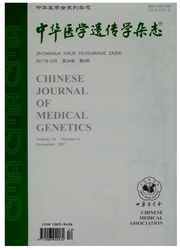

 中文摘要:
中文摘要:
目的对3例眼皮肤白化病(oculocutaneous albinism,OCA)患儿进行分型诊断,并在此基础上开展OCA4产前基因诊断研究,为临床OCA遗传咨询和产前诊断提供指导。方法应用聚合酶链反应及DNA序列测定技术,确定先证者及其父母的基因型后,取绒毛或羊水进行产前基因诊断。结果3例患儿均为OCA4。家系1患儿母亲后来两次怀孕,第1次诊断为患儿,已选择流产,再次怀孕时诊断为父源G349R致病基因携带者。家系2产前诊断结果显示胎儿既未获得父源突变,也未获得母源突变。家系3产前诊断结果显示胎儿仅获得父源G349R突变。结论检出MATP基因3种已报道的OCA4致病性突变G349R、D160H和P419L,发现1种致病性新突变c.870delC。
 英文摘要:
英文摘要:
Objective To provide guidance for clinical genetic counseling and prenatal diagnosis of oculocutaneous albinism (OCA) in China. Methods PCR and automatic DNA sequencing were applied to obtain the genotypes of the patients and their parents in three Chinese albinism families. Prenatal gene diagnoses were performed at early pregnancy by chorionic villus sampling (CVS) or by amniocentesis at mid- pregnancy. Results The three patients were all OCA4, whose genotypes were G349R/c. 870delC, G349R/ P419L, G349R/D160H, respectively. The three couples had been diagnosed as carriers. In family 1, the first fetus was diagnosed as affected. Termination of pregnancy was opted following genetic counseling. The second fetus (monozygotic twin) was heterozygous only with the paternal G349R mutation. The fetus in family 2 did not get either one of the two mutations. The fetus in family 3 was heterozygous only with the paternal G349R mutation. Conclusion This study detected three reported pathogenic mutations of the membrane associated transporter protein gene (MATP), including G349R, D160H and P419L, and identified a novel pathogenic mutation c. 870delC. The prenatal gene diagnosis of OCA4 will be important to prevent the birth of affected child.
 同期刊论文项目
同期刊论文项目
 同项目期刊论文
同项目期刊论文
 期刊信息
期刊信息
